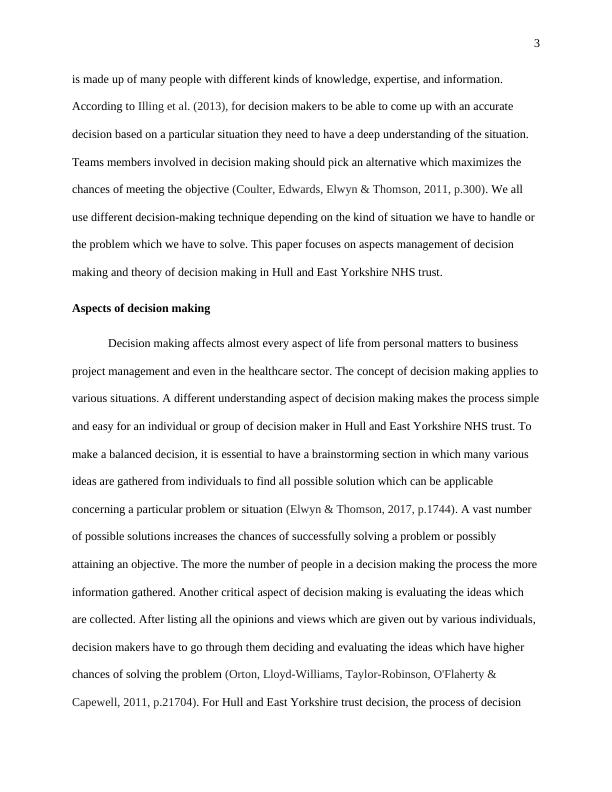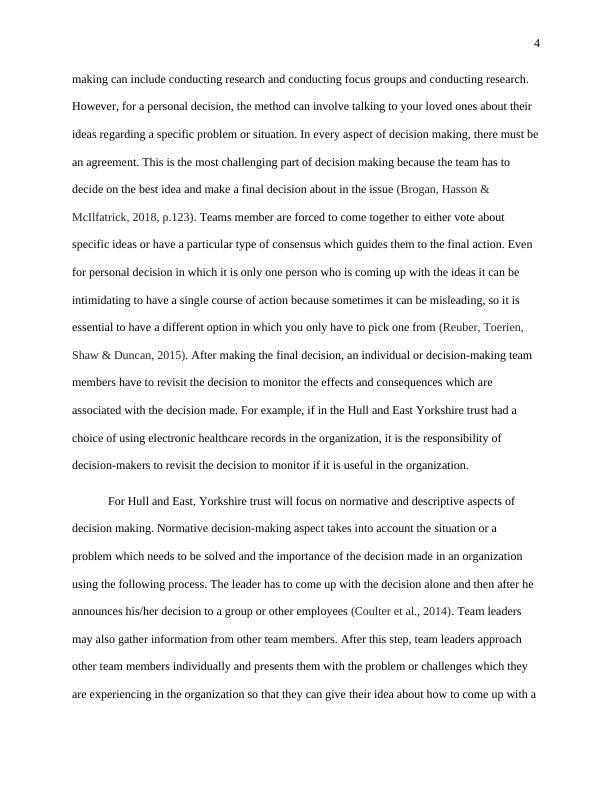Decision Making in the NHS
Added on 2023-06-08
12 Pages3789 Words50 Views
DECISION MAKING IN THE NHS
Name:
Institution:
Instructor:
Course:
Date:
Name:
Institution:
Instructor:
Course:
Date:

2
Introduction
Decision making is a significant activity which is conducted in an organization with the aim of
selecting the best option between two or more alternatives which can lead to positive results in
an organization. In every making, there can be positive or negative results of each decision
which is meant. Decision-making process plays a very vital role in our daily lives. Some
decision which we make a not that important but some other are very essential in our daily lives
(Elwyn et al., 2010). The decision-making process can be categorized into programmed or
routine and non-programmed which are strategic decision making. Routine decisions are those
decisions which we apply them in our daily lives to solve issues which keep on repeating
themselves, and they are often anticipated. A non-programmed decision is aimed at addressing
problems which are unanticipated, and they do not occur frequently, and they rely on personal
intuition and experience (Williams, McIver, Moore & Bryan, 2008, p.7). In this kind of decision
making, a person has to identify the problem and come up with appropriate action which can
handle the problem by making the right decision (Elwyn et al., 2012, p.1361). When an
organization is faced by a problem, the primary issue which they face is to decide whether
decisions have to be made by the organization top leaders or all the employees in the institution
should participate in the decision-making process to be able to come up with a solution.
Decision-making process is organized depending on whether a group or an individual formed it.
Individual and group decision making have some advantage and disadvantages. Benefits
of the individual decision-making process are that it takes a short time and it does not create
conflicts which can arise in a group decision-making process because it involves many people
with various views. Advantages of the group, decision-making process, are that it is possible to
gather a lot of information regarding a situation and how to handle a specific problem because it
Introduction
Decision making is a significant activity which is conducted in an organization with the aim of
selecting the best option between two or more alternatives which can lead to positive results in
an organization. In every making, there can be positive or negative results of each decision
which is meant. Decision-making process plays a very vital role in our daily lives. Some
decision which we make a not that important but some other are very essential in our daily lives
(Elwyn et al., 2010). The decision-making process can be categorized into programmed or
routine and non-programmed which are strategic decision making. Routine decisions are those
decisions which we apply them in our daily lives to solve issues which keep on repeating
themselves, and they are often anticipated. A non-programmed decision is aimed at addressing
problems which are unanticipated, and they do not occur frequently, and they rely on personal
intuition and experience (Williams, McIver, Moore & Bryan, 2008, p.7). In this kind of decision
making, a person has to identify the problem and come up with appropriate action which can
handle the problem by making the right decision (Elwyn et al., 2012, p.1361). When an
organization is faced by a problem, the primary issue which they face is to decide whether
decisions have to be made by the organization top leaders or all the employees in the institution
should participate in the decision-making process to be able to come up with a solution.
Decision-making process is organized depending on whether a group or an individual formed it.
Individual and group decision making have some advantage and disadvantages. Benefits
of the individual decision-making process are that it takes a short time and it does not create
conflicts which can arise in a group decision-making process because it involves many people
with various views. Advantages of the group, decision-making process, are that it is possible to
gather a lot of information regarding a situation and how to handle a specific problem because it

3
is made up of many people with different kinds of knowledge, expertise, and information.
According to Illing et al. (2013), for decision makers to be able to come up with an accurate
decision based on a particular situation they need to have a deep understanding of the situation.
Teams members involved in decision making should pick an alternative which maximizes the
chances of meeting the objective (Coulter, Edwards, Elwyn & Thomson, 2011, p.300). We all
use different decision-making technique depending on the kind of situation we have to handle or
the problem which we have to solve. This paper focuses on aspects management of decision
making and theory of decision making in Hull and East Yorkshire NHS trust.
Aspects of decision making
Decision making affects almost every aspect of life from personal matters to business
project management and even in the healthcare sector. The concept of decision making applies to
various situations. A different understanding aspect of decision making makes the process simple
and easy for an individual or group of decision maker in Hull and East Yorkshire NHS trust. To
make a balanced decision, it is essential to have a brainstorming section in which many various
ideas are gathered from individuals to find all possible solution which can be applicable
concerning a particular problem or situation (Elwyn & Thomson, 2017, p.1744). A vast number
of possible solutions increases the chances of successfully solving a problem or possibly
attaining an objective. The more the number of people in a decision making the process the more
information gathered. Another critical aspect of decision making is evaluating the ideas which
are collected. After listing all the opinions and views which are given out by various individuals,
decision makers have to go through them deciding and evaluating the ideas which have higher
chances of solving the problem (Orton, Lloyd-Williams, Taylor-Robinson, O'Flaherty &
Capewell, 2011, p.21704). For Hull and East Yorkshire trust decision, the process of decision
is made up of many people with different kinds of knowledge, expertise, and information.
According to Illing et al. (2013), for decision makers to be able to come up with an accurate
decision based on a particular situation they need to have a deep understanding of the situation.
Teams members involved in decision making should pick an alternative which maximizes the
chances of meeting the objective (Coulter, Edwards, Elwyn & Thomson, 2011, p.300). We all
use different decision-making technique depending on the kind of situation we have to handle or
the problem which we have to solve. This paper focuses on aspects management of decision
making and theory of decision making in Hull and East Yorkshire NHS trust.
Aspects of decision making
Decision making affects almost every aspect of life from personal matters to business
project management and even in the healthcare sector. The concept of decision making applies to
various situations. A different understanding aspect of decision making makes the process simple
and easy for an individual or group of decision maker in Hull and East Yorkshire NHS trust. To
make a balanced decision, it is essential to have a brainstorming section in which many various
ideas are gathered from individuals to find all possible solution which can be applicable
concerning a particular problem or situation (Elwyn & Thomson, 2017, p.1744). A vast number
of possible solutions increases the chances of successfully solving a problem or possibly
attaining an objective. The more the number of people in a decision making the process the more
information gathered. Another critical aspect of decision making is evaluating the ideas which
are collected. After listing all the opinions and views which are given out by various individuals,
decision makers have to go through them deciding and evaluating the ideas which have higher
chances of solving the problem (Orton, Lloyd-Williams, Taylor-Robinson, O'Flaherty &
Capewell, 2011, p.21704). For Hull and East Yorkshire trust decision, the process of decision

4
making can include conducting research and conducting focus groups and conducting research.
However, for a personal decision, the method can involve talking to your loved ones about their
ideas regarding a specific problem or situation. In every aspect of decision making, there must be
an agreement. This is the most challenging part of decision making because the team has to
decide on the best idea and make a final decision about in the issue (Brogan, Hasson &
McIlfatrick, 2018, p.123). Teams member are forced to come together to either vote about
specific ideas or have a particular type of consensus which guides them to the final action. Even
for personal decision in which it is only one person who is coming up with the ideas it can be
intimidating to have a single course of action because sometimes it can be misleading, so it is
essential to have a different option in which you only have to pick one from (Reuber, Toerien,
Shaw & Duncan, 2015). After making the final decision, an individual or decision-making team
members have to revisit the decision to monitor the effects and consequences which are
associated with the decision made. For example, if in the Hull and East Yorkshire trust had a
choice of using electronic healthcare records in the organization, it is the responsibility of
decision-makers to revisit the decision to monitor if it is useful in the organization.
For Hull and East, Yorkshire trust will focus on normative and descriptive aspects of
decision making. Normative decision-making aspect takes into account the situation or a
problem which needs to be solved and the importance of the decision made in an organization
using the following process. The leader has to come up with the decision alone and then after he
announces his/her decision to a group or other employees (Coulter et al., 2014). Team leaders
may also gather information from other team members. After this step, team leaders approach
other team members individually and presents them with the problem or challenges which they
are experiencing in the organization so that they can give their idea about how to come up with a
making can include conducting research and conducting focus groups and conducting research.
However, for a personal decision, the method can involve talking to your loved ones about their
ideas regarding a specific problem or situation. In every aspect of decision making, there must be
an agreement. This is the most challenging part of decision making because the team has to
decide on the best idea and make a final decision about in the issue (Brogan, Hasson &
McIlfatrick, 2018, p.123). Teams member are forced to come together to either vote about
specific ideas or have a particular type of consensus which guides them to the final action. Even
for personal decision in which it is only one person who is coming up with the ideas it can be
intimidating to have a single course of action because sometimes it can be misleading, so it is
essential to have a different option in which you only have to pick one from (Reuber, Toerien,
Shaw & Duncan, 2015). After making the final decision, an individual or decision-making team
members have to revisit the decision to monitor the effects and consequences which are
associated with the decision made. For example, if in the Hull and East Yorkshire trust had a
choice of using electronic healthcare records in the organization, it is the responsibility of
decision-makers to revisit the decision to monitor if it is useful in the organization.
For Hull and East, Yorkshire trust will focus on normative and descriptive aspects of
decision making. Normative decision-making aspect takes into account the situation or a
problem which needs to be solved and the importance of the decision made in an organization
using the following process. The leader has to come up with the decision alone and then after he
announces his/her decision to a group or other employees (Coulter et al., 2014). Team leaders
may also gather information from other team members. After this step, team leaders approach
other team members individually and presents them with the problem or challenges which they
are experiencing in the organization so that they can give their idea about how to come up with a

End of preview
Want to access all the pages? Upload your documents or become a member.
Related Documents
Leadership and Decision Making in the Education Sector of Australialg...
|13
|3293
|198
Reflective Writing Assignment (Doc)lg...
|6
|1811
|41
Self-Care About Anxiety: A Personal Experiencelg...
|10
|2975
|65
Critical Thinking and Managerial Decision Making: Doclg...
|8
|2134
|71
Consumer Decision-Making Process: Stages and Implicationslg...
|22
|4510
|243
The mellow bumps an intervention programlg...
|10
|1082
|19
